Eber’s water towers – Great Britain
The leading trade journal in Sweden, VA-tidskriften Cirkulation has since 1998 an article series under the heading Ebers vattentorn (Eber’s water towers), where Eber Ohlsson with text and photo presents interesting water towers in the world (except Scania and Sweden). Below is a free translation to English of these texts.
Eber’s water towers in Cirkulation 4/2023
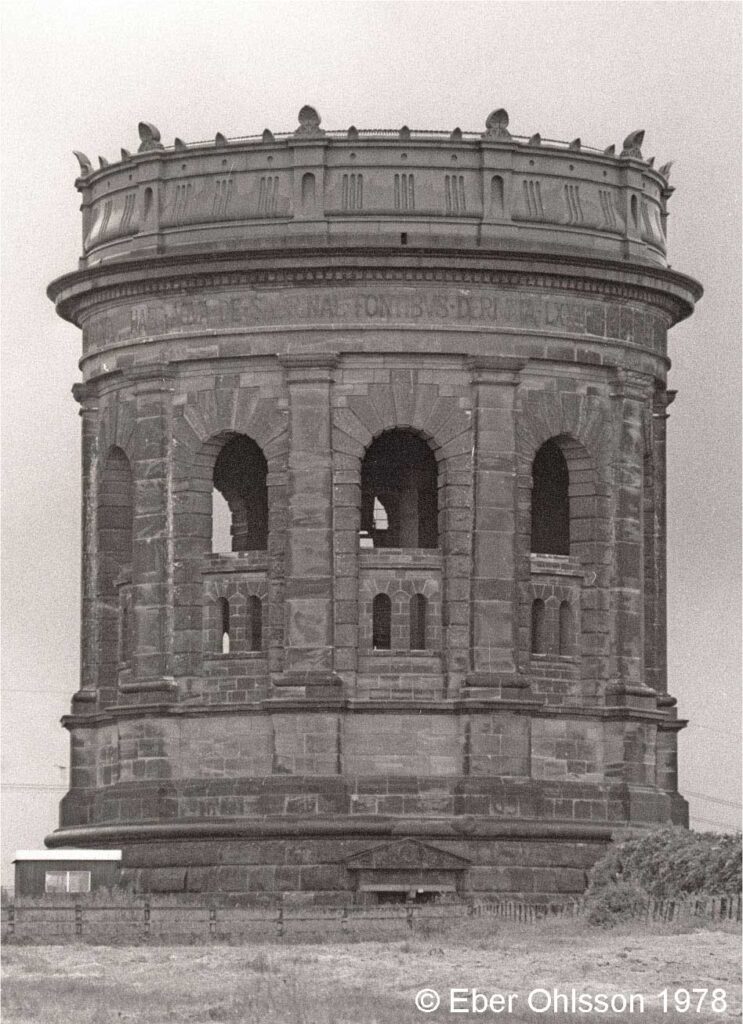
A free translation to English:
Many cities in Industrial Revolution Britain grew very large, an expansion that required large-scale water supplies. If there were no good water sources in the immediate area, you had to look further afield. Liverpool then had to take their water from the 130 km away situated Lake Vyrnwy in Wales.
In the suburb of Runcorn, upstream from Liverpool and south of the River Mersey, a red sandstone water tower, 30 m high with a diameter of 25 m and with a cast iron reservoir of 3,000 m3, was built in 1888-92 as part of the pipeline. It was designed by George F. Deacon and has a frieze with a Latin inscription.
Published 2017-11-08
Eber’s water towers in Cirkulation 7/2017
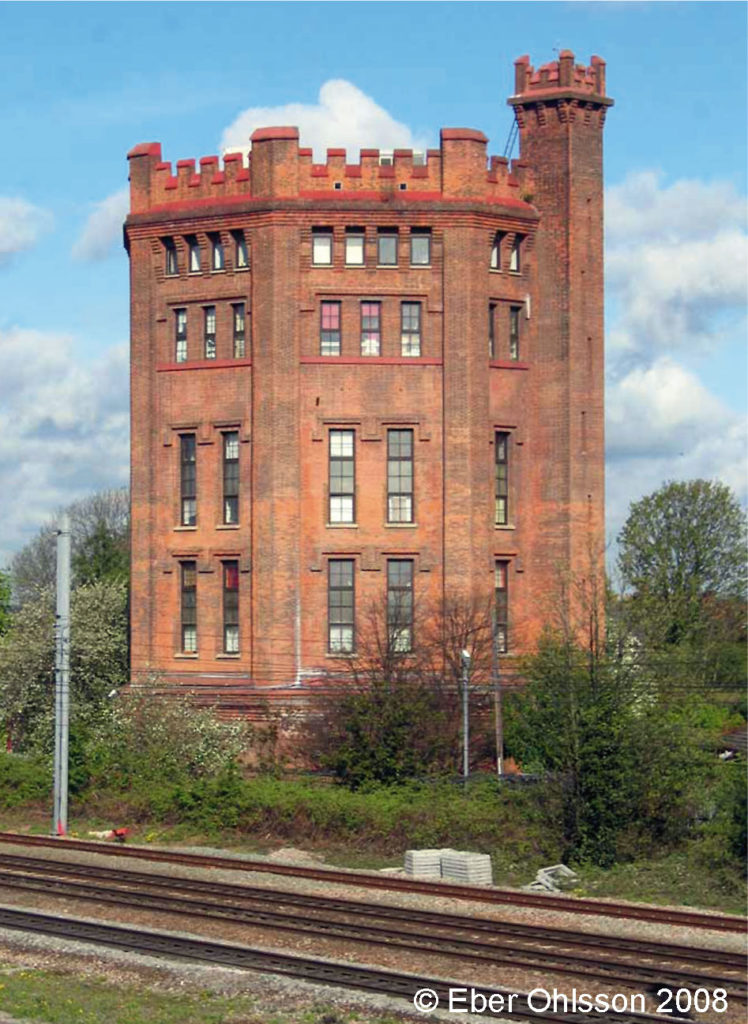
A free translation to English:
Great Western Railway is a legendary railway in England. It had traffic from Paddington station in London and westward. Chief engineer was the famous Isambard Kingdom Brunel, who chose the broad-gauge of 2 134 mm, a gauge which, however, was later changed to our standard-gauge of 1 435 mm.
In Southall, 15 km west of Paddington, the railway built 1895 by Hanson Brothers an octagonal 32 meter high water tower with crenellation, known as Southall’s ’Castle’, where the steam engines could fill water until 1968. The old Victorian water tower was reconstructed in 1983 into one- and two-room flats.
Published 2017-11-08
Eber’s water towers in Cirkulation 5/2012
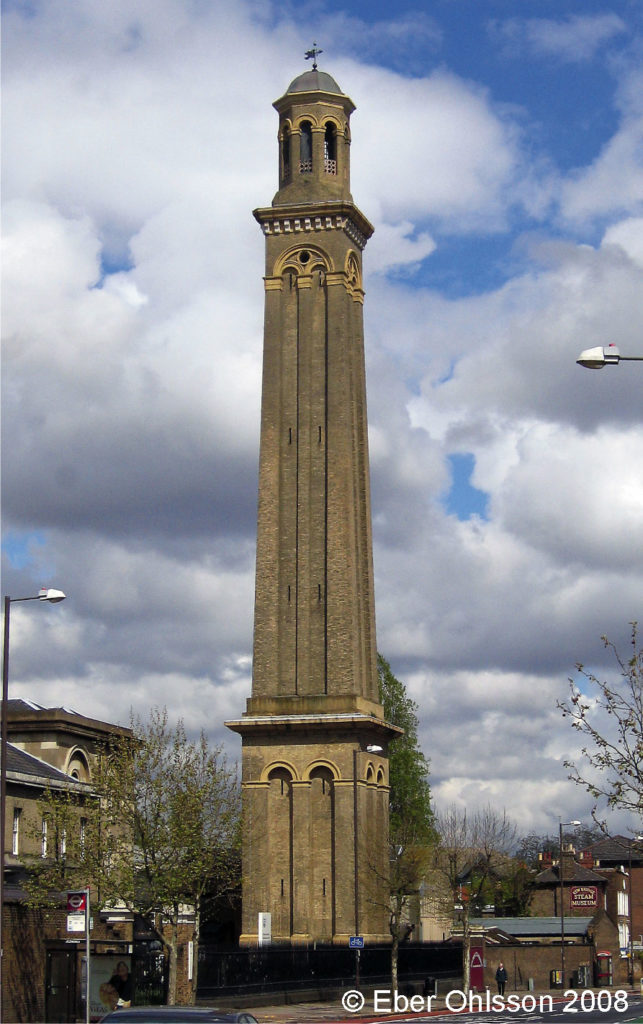
A free translation to English:
Water as water, was perhaps the thought when one canal company in England 1811 founded a water company, Grand Junction Waterworks Company, at a time when water supply in London was run by private companies. 1883 they built a pumping station in western London, Kew Bridge Pumping Station.
With the help of steam engines water was pumped from Thames to a slow sand filter and then out on the net. It was built in 1867 a 61 meter high standpipe. These are in the Anglo-Saxon world sometimes called water towers. Pump station operation was closed down in 1944, and since 1973 is here a museum, with steam operation every weekend.
Published 2012-08-29
Eber’s water towers in Cirkulation 3/2010
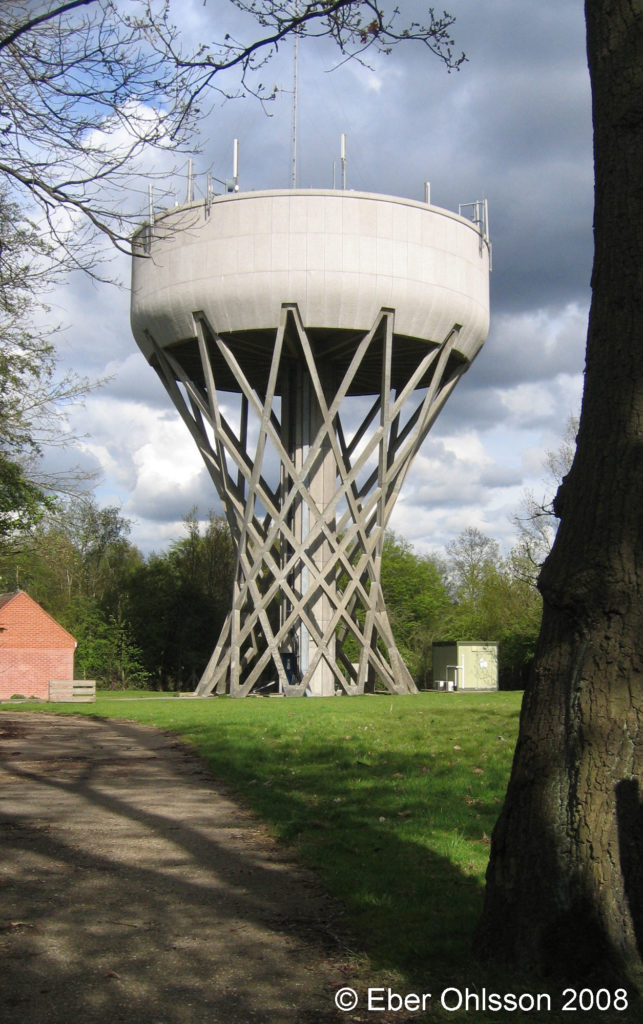
A free translation to English:
Pillars or struts that carry up a water tower shall not only on a safe way fill the function, but shall also visual convince the viewer about it. The concrete water tower in Trent Park in Cockfosters in the north London hopefully does this. Building proprietor was the then Lee Valley Water Company, with the Chief Engineer J.W. Milne and the General Manager E.H. Riley.
The straight struts forming a striking interlaced hyperbolic lattice; there every strut is inclined 120° to the ground. The tower, which for some time, there were plans to have a restaurant at the top, is from 1968 and has a reservoir of 1 130 m³. It is owned today by Veolia Water UK.
Published 2010-04-28
Eber’s water towers in Cirkulation 1/2009
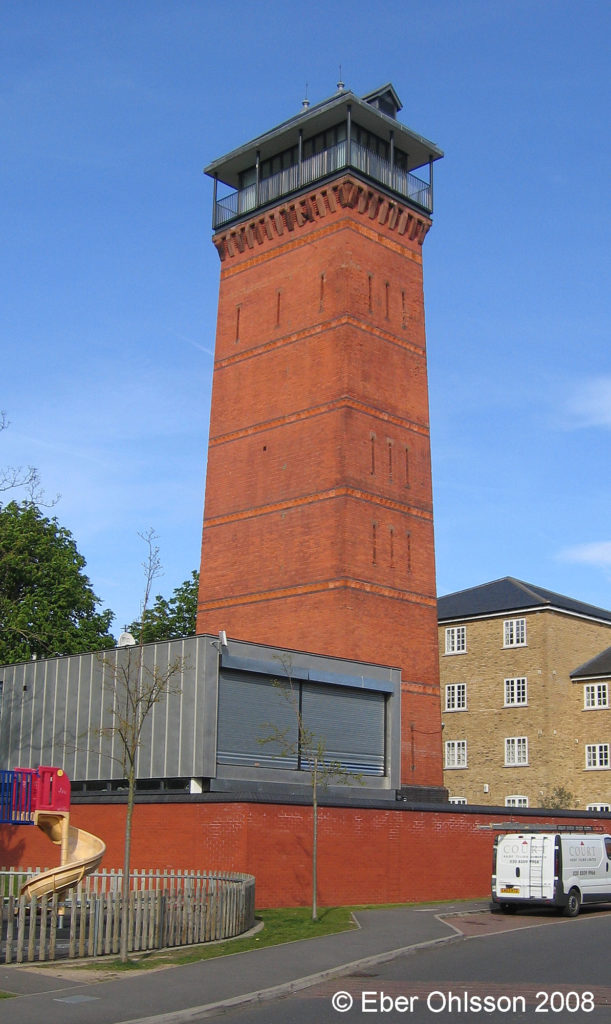
A free translation to English:
Those who want to live a high life, have now the opportunity to do it in London. Here can you today buy a Victorian rebuilt water tower at the earlier Brook Hospital, south of Greenwich to a price of 15-20 millions of Swedish crowns. The high life is not cheaply. Then you get a house of 330 m², that except the water tower even include a ground-close extension building in two floors.
The remaining rooms are found in the ninth floors tower, one on each floor and with minimal windows. Fortunately is there a lift and a staircase, even if these take half of the area. On the top is there a room with prospect over the entire London. Is it maybe a priceless prospect?
Published 2009-02-11
Eber’s water towers in Cirkulation 3/2004
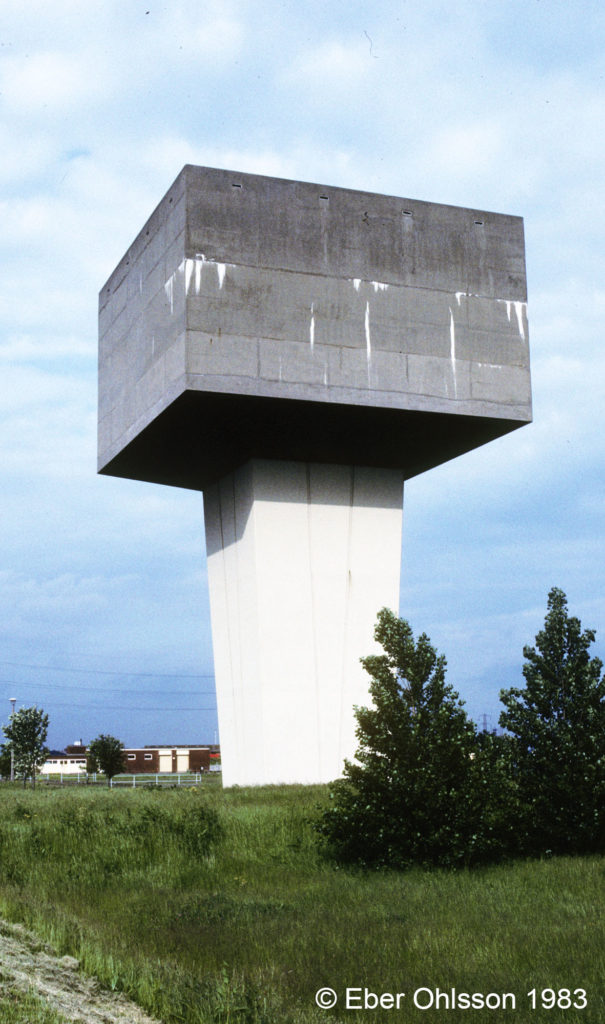
A free translation to English:
The rotation symmetric form round a vertical axle is a very usual design of the water tower reservoirs, and there are good reasons why many towers got this form. A water tower that definitely not belongs to this category was there 1983 on one of the largest sewage treatment plant in Europe – the Beckton Sewage Treatment Plant in the east London, Great Britain.
This concrete water tower was radical avoided from the rotation symmetric form, but it has probably been easier to make the mould. The owner of the Beckton Plant, Thames Water has unfortunately no information of the technical data or of the architect.
Published 2004-04-28
Eber’s water towers in Cirkulation 5/2001
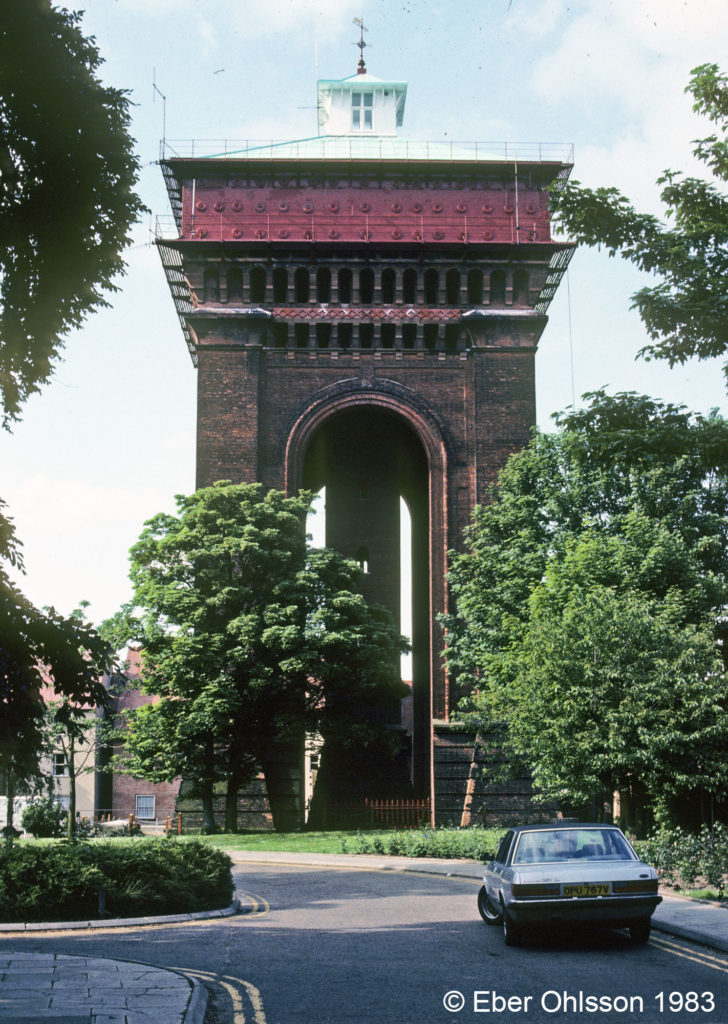
A free translation to English:
A struggle is going on concerning a Victorian water tower in the English city Colchester. The city is founded by Romans and situated in the Essex County less than 100 kilometres north-east London. The group that wants to preserve the water tower in its original form is calling their campaign ”Save Jumbo for Colchester”.
The name Jumbo, named after an elephant in the London Zoo, got the tower already from the birth 1883. The 40 meter high tower, built by 1,2 millions bricks and holding a cast iron reservoir on 1 000 m³ cost at that time 11 000 £. The tower was put out of operation 1987 by the Anglian Water, and sold to new exploiter for 100 000 £.
The struggle is now between owner that wants a commercial rebuilding and a campaign group that want that the tower get a function dignified its history and will be accessible to the public. The picture of the tower is from 1983; at that time had the writer no knowledge of the 100 year’s jubilee.
Published 2001-08-29
